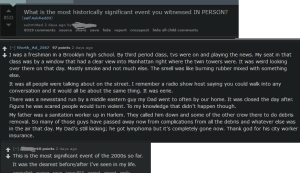
Recent Posts
Social Media Intervention
The Process:
Check your screen time on your phone for the last week. Download the app Unpluq (black and yellow logo) and make an account. It will ask questions about your schedule, phone usage, as well as a choice to pick two apps to put blocks on. Choose the two social media apps that you use most (for example mine is instagram and tik tok so I chose those). Choose the time you regularly/usually go to bed during the week and block those apps one hour before that. This will prevent you from going on your social media apps as much right before you sleep as well as right when you wake up. Give yourself an hour/30 minutes before checking your phone when you wake up as well as when you go to sleep. Also, change your phone to black and white. Since everything on your phone has certain colors to catch your attention, making them black and white will make it less likely for you to click on something and get distracted with it. This should prevent screen time with high usage. You can find how to do this in your phone’s settings. With these changes your screen time should be down from the previous and you should notice a lot of changes with how you spend your time. While you catch yourself in a moment like this, write down on a piece of paper or in your notes about some new things you accomplished or did as a result of not being on your phone. At the end of the week, check your screen time and compare it to what it was last week. Hopefully it went down and hopefully you realize how toxic and unhealthy social media is and how long you spend on it.
The results:
For this intervention, I wanted to intervene in people’s daily lives and how they regularly use their phones and social media. I got inspiration from Chris Burden who was willing to put his health on the line in order to create his artwork. I decided I wanted my intervention to be something drastic like how Chris Burden did his work so I decided to hit our generation in its weak spot, taking away our social media. Of course, it was not nearly as physically dangerous as Chris Burden’s work but it was still mentally difficult to stay disciplined. So, I got a group of 6 people (roommates and suitemates) and gave them the above information. I encourage everyone reading to partake as well. They decided to do this for the week and see how it impacted their screen time as well as their day to day lives. I got tremendous feedback from my friends and they said it was an eye opening experience. All of their screen times went down by at least two hours, some even more. One of my friends decided to go rock climbing at the local gym in Fenway since he was not on his phone all day. Another one of my friends enrolled in a spikeball tournament and won with another one of my friends. They all found better alternatives in their lives rather than being glued to their screen all day. They also said their sleep schedule improved after a rough first few days since they were not used to going to sleep without their phone. Once they got over the first few days, it was easy to fall asleep since they accomplished a lot more throughout the day and were tired from it.
Intervention Project: Friendly Fire
For my intervention project, I chose to intervene in the gameplay of Overwatch 2, specifically creating a game within the boundaries of the original game to completely ignore the already established goal. In my game, instead of pushing the payload or claiming the objective, your goal as the player is to sneak into the enemy team’s backlines to befriend as many players on the enemy team as you can. This directly contradicts the objective the original game has set up for you, as the only feasible way you can win a game of overwatch is by killing the enemy team as often as possible. My game further intervenes with Overwatch because in all of Overwatch’s existence, the game has been infamous for hosting a primarily negative and mean player base. Players take the game too seriously, they are not here to make friends, they are here to win. MY game does the exact opposite of this – you don’t win by winning the game, you win by making friends.
My project takes some inspiration from Yoko Ono’s cut piece, to provide some sense of vulnerability to the player and leaving the fate of their game up to the reactions of the other players. I wanted to try and show that making friends was harder, yet more rewarding, than making enemies, and put that idea in the context of a game. By letting my game be decided by other players, it proved to be a lot of fun to see the varying reactions from these people I didn’t know.
My results:
I initially expected very minimal success in my attempts to make friends with the enemy team, but I was pleasantly surprised to find many people were willing to throw the game with me. In every game I played, I was able to find at least one person from the other team who was willing to say hello and never attack me when I approached. However, for every one person willing to spam voice lines with me in the backlines, there was always at least one person on either my team or the enemy’s who would tell me off or attack me. Still, it was a much more divisive split between friendly/non-friendly players that I encountered while playing my intervening game. A nice side note I encountered was that in every game, I got at least 2 endorsements from the random people I played with each game! So while I might have lost every single game I played with this new ruleset, I made plenty of friends.
Link to the presentation:
https://docs.google.com/presentation/d/1eKE2m1-s-Jtg3CdxkmaqQXl0jPDRZ2JHBu_S4kkxz_0/edit#slide=id.g29857f60692_0_0
Hidden Blocks can be Fun!
Artists Statement:
For this project, I started by asking myself if there was any existing process or idea in this world that I wanted to change or go against. This proved to be quite a difficult task at first. There are many things that I wish could change but a lot of them felt extremely serious or I struggled to grasp how I would come up with an idea for a game from it. That is when I asked my friends what they were thinking of doing. Jonathan mentioned that he was thinking of using Mario Maker for his project. That’s when my idea hit me! I love watching and playing difficult Mario levels, known as Kaizo levels in the community. Kaizo levels are extremely prominent because of their difficulty and because of a concept that has been lovingly dubbed the “Kaizo Block.” Kaizo Blocks are hidden “?” Blocks are infamous in the community because they are purely meant to troll players and impede progress. They often find themselves in places where players feel safe to jump so they will try, hit the block, and fall into a pit. They can also be used to supplement bad level design by serving as an invisible wall to prevent players from doing something unintended. These terrible traits are what made the concept so infamous to the point that players sometimes will not finish a level if they hit a Kaizo Block. The Kaizo Block rightfully feels like it should be a concept that stays in the dumpster, right? That is when my idea came in, what if I could show people that they are fun? After all, Kaizo Blocks are just hidden blocks that can be used as a tool. That kicked off my journey to find a way to make hidden blocks fun, which ended up being extremely difficult. Throughout the process, I was inspired by “Spacewar.” When I was in high school, I had the chance to play “Space War” against someone while Steve Russel watched. That experience and the story behind it have always been an inspiration to me. He was able to take something that people had one intended way of using, in this case, the university computer, and turn it into something fun that would spawn communities around the world. I wanted to also change the Kaizo Block from a dreaded part of a level into something that the community would find fun. Another inspiration was the switched Barbie and GI Joe dolls. The idea of shifting what everyone was used to while also making a commentary on the state of the medium appealed to me. This project was an intervention because it was posted to the community and anyone in the game can randomly run into the level or choose to play it. I wanted to do this because often players who see hidden blocks will quit the level, but if they tried my level they would hopefully find the fun and beat it.
Documentation / Process:
As I mentioned above this process was a difficult one. The level went through a lot of different iterations as I learned more about what I could not do with hidden blocks. It turns out that they were way more limited than I thought when I started. I tried to make a bunch of interesting contraptions with horizontal moving Thwomps and Kaizo-style difficulty, but I swiftly realized that I was being limited by the Hidden Block. Next, I tried shifting over to the New Super Mario Bros. theme to make a simple level but around ground pounding the hidden blocks. That did not work either because of the limitations of the hidden block. I was ready to throw in the towel when I was hit with an idea. Since I can only hit a hidden block from below, what if I up-toss a shell? I tried it in the Super Mario World theme and it worked… sort of. It didn’t work the way I expected but it did make the hidden block visible. I could work with this concept. That spawned the level that I ended up posting. The basic concept of the level is that there are two sub-areas. The first has all the blocks visible but needs a key to open a door, the second has all hidden blocks and the key. Players have to get the key and open the door to finish the level.
The level can be found while playing randomly online or by typing the code: 1VB-XP3-NQF
I was shocked by the results of my level! Within half a day, my level was played by 12 community members, had 120 attempts, had 2 comments, and 1 like! Random people were playing my level and at least 1 person enjoyed it! There were a few metrics that I did not expect though. The clear rate was 6.66% and the world record completion time was 5.65 seconds. This meant that the majority of people still found the level difficult and that people were beating the level in an unintended way. This initially made me disheartened until I remembered my inspirations. I was inspired by Kaizo levels and intervention art. 5.65 seconds is seemingly impossible unless you do Kaizo-level tricks like a shell jump. That is cool because people were finding the fun and the level was difficult like a Kaizo level should be. Additionally, this brought an interesting detail to my attention. Sr Depreso had the world record on my level. I don’t know too much about them but I know they are a prominent Mario Maker 2 level creator, with one of their levels being featured in a Watch Mojo video. That meant that my intervention had worked!



Reddit Moment™: The Social Experiment™
Rules and Gameplay
The rules and directions for this game is very simple:
- Navigate to the subreddit r/Askreddit
- Identify a new or rising post asking a question that pertain to opinions, personal anecdotes or anything not about factual information or hypothetical situations
- To the best of your ability and using any available tools or resources, reply to the post (ideally using a burner account) with a completely fabricated yet convincing and seemingly genuine answer
- Wait a day and return to your comment and see how much upvotes your fake post have accrued
Artist’s Statement
While most of the examples we saw in tactical media that relates to the internet are somewhat dated, the social commentary they sent are still as relevant now as ever: the uncertainty of who is on the other end, the murky nature of the truthfulness of anything you see online, and just how easy it is for it to be subverted or compromised without you noticing. With those elements in mind, I chose my intervention to take place on reddit, a (mostly) anonymous online forum that frequently see the three previously mentioned elements at play. Reddit is known for its users’ (redditors) hive-mind like echo chambers, and an elitist, know-it-all and often very hypocritical attitude on every subject and opinion imaginable. One thing that especially stands out is that redditors often point out the flaws of other social media sites – that they are riddled with spam and bots, promote misinformation, use pervasive algorithms, have ineffective moderation – to assert how much superior reddit is, even though it suffers from the same problems.
There are many subreddits where users can post questions or personal stories for answers, discussion or advice, and all of them are infamously known to contain made up stories, reposts, incorrect “facts”, “baits“ designed to spark outrage or to farm upvotes, and some combinations of the above. Yet for many of these posts, often despite being called out, still get enough upvote to be pushed onto the front page. My game/experiment seek to contribute by fanning the flames of this problem to see just how easy it is to make things up and to fool others, so I chose to conduct this game on r/Askreddit, one of the largest community on the website with over 40 million users and posts regularly getting tens of thousands of upvotes. There is no limit to what or how you create your response to a post, including copying someone else’s reply to a similar question from a long time ago, to using AI such as chatGPT to generate answers – both have become increasingly common on the website.
Other than the often repeated “don’t trust everything you read online” bit, the other problem I want to raise – which of course also isn’t exclusive to reddit – is the nature of these kinds of online content and how we are consuming them: as most of the posts and replies are about opinion or personal anecdotes, how much do we really care about the authenticity of them? Are we reading these posts to genuinely engage with others’ opinions, or are we just reading for a quick laugh? All of us are ultimately vulnerable to misinformation, yet we still have to place some amount of intrinsic trust into other strangers online – no matter how much we tell ourselves “don’t believe everything”. And since some of the things we see and read may never be truly verified, what do we make of this fact?
Results
Unfortunately the result of this game/experiment is mixed, as none of the posts got anywhere near a large amount of upvotes and barely any engagement. This is somewhat expected however, as luck plays a massive role in whether your reply or the post you replied to “takes off”. Repeat enough times, it is almost certain one of the posts will make it to the top.
The most successful posts:
talking about the dangers of garage door springs is a reddit classic that pops up in every single thread that asks a question like this one
this lengthy reply is almost completely copied verbatim from under another similar question months ago, and it also got a reply!
other completely made up scenarios
Green Heaven – Treasure Hunter
This game is a treasure hunting game that tries to strengthen the importance of green spaces in cities, and intervene with urban planning, lack of green spaces, and the prioritization of commercial and residential developments over public parks and recreational areas. Every treasure location will be a green area in downtown Boston. The treasure will be plant’s seeds which can somehow motivate players to take more care of the urban environment and try to intervene with it by growing plants on their own in the city. This Game will be a long term game that will last either 3-7 days fully online via social media such as Discord channel or Group DMs. The GM (me) will post hints everyday on social media, including a screenshot on the general green area of where the treasure is, and 2-3 pictures shot from the POV of the location of treasure. The idea of fully virtual and no NPC is involved in person was inspired by the game Uncle Roy All Around You, but the ultimate goal of this game is about helping environment instead of helping random strangers.
The initial idea was inspired by Pac Manhattan where is conducted and intervening in downtown city. It was only a 1 day treasure hunt event and it will take multiple stops to reach the final treasure. However, I feel like making it a long term event will better strengthen the importance of green space since it encourages players to visit a green area to seek treasure and receive different plant’s seeds everyday. Moreover, instead of giving a set of instructions of where to go, giving a general area and some visual hints will be more fun to play from a player perspective, because this creates more affordances for players to move on their own rather than simply following instructions.
DAY1 Hints
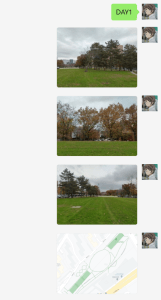
DAY2 Hints
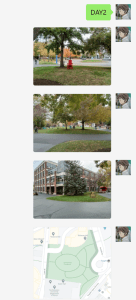
DAY3 Hints
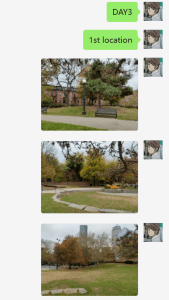
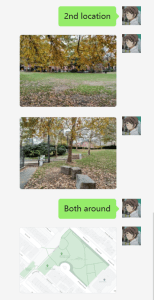
Unfortunately, I only had 1 playtester for one of the daily treasure hunts. This seeking part is definitely fun and not too difficult, but the reward may seem a little unsatisfying since it basically plants. Perhaps adding more rewarding treasures on to plant’s seeds will intrigue more players to join this game.
Where the treasures are:


Playtesting:
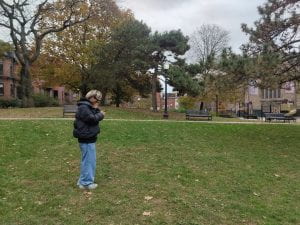
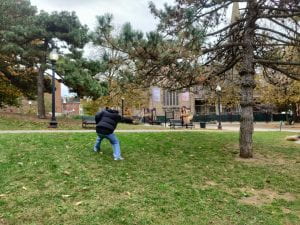
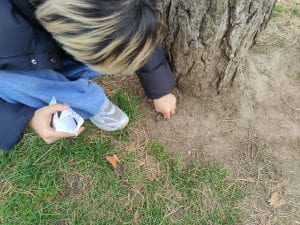
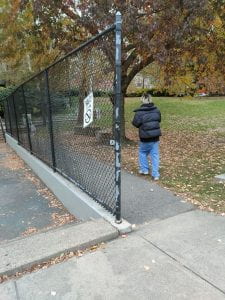
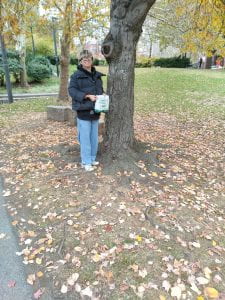
Intervention: Uncle Roy Koopa
My project is “Uncle Roy Koopa: All Around You,” a scavenger hunt that takes place in Mario Maker 2.
Players enter the level as normal, but will quickly realize that the only way to beat it is to enter a 5-digit code they don’t know. In a floating comment, the character “Uncle Roy Koopa” (based on the koopaling from the original Mario games) explains what’s going on. He says, “The code is at my other home. QX8-G82-2WG.” The sequence he gives is the ID for a completely different level. Players will then have to play that level, explore obscure parts of the map, and find *another* floating comment that states which level to try next. All in all, there are three levels the player has to explore before getting the final code.
The point of this game is to disrupt the way people play Mario Maker levels. In general, the community treats levels as very disposable, playing a level quickly from start to finish, and then forgetting about it. This is very unfortunate to me, since it reflects the increasingly apathetic way that people are engaging with art. Instead of being a meaningful experience that makes people think or feel, people are just consuming and moving on. I wanted to see if I could break that trend by turning a Mario Maker level into a more mysterious, longer-term experience.
The biggest inspiration for this level (probably obvious) was “Uncle Roy: All Around You.” While this game doesn’t have the social aspect of that experience, it does have the element of interacting with the world differently than we normally would. Instead of treating our cities as a simple, start-to-finish experience (go to the store–then we’re done), the game encourages people to find wonder and intrigue by exploring areas of their city they probably don’t normally visit. Because of that, I thought it was a great intervention model to follow.
This game has changed a little bit since I first came up with the idea. The biggest difference from before is that it used to be a social experience, where users would leave comments to pledge that they’d “be there for someone they don’t know.” That isn’t really practical in Mario Maker 2, since the active player base isn’t what it used to be size-wise, and so forming a lot of pairs like the original “Uncle Roy” can’t really happen.
Link to a video of the level: Link
Thoughtless Objectives
Title: Thoughtless Objectives
Inspiration:
- Watching the video that Jen and Derek put on with the man deciding what the woman should do and what decisions they should make
- Then thought about how I write stuff and how others influence my decisions when I’m writing
Supplies:
- Notebook/Journal (preferably on the cheaper side)
- A pencil or pen
Setup:
- There will be one person with a notebook(the notetaker)
- Next, there is at least 1 person (a person) who will get the notebook and decide what they want to change in it (They can either overwrite, erase, nothing, or be creative).
- There will be a neutral judge that will decide whether the objective is complete or if the objective is possible
Before Playtest:
Gameplay:
- The notetaker will write down what they want for two minutes while the person tries to influence their decision (by talking, moving, or anything besides physical interaction)
- The notetaker’s goal is to write/draw something that is beneficial for them. Without letting, the person’s influence get to them
- When the person gets the notebook, they have 30 seconds to do whatever they want to the notebook. (obviously not destroy the notebook or make it unusable)
- The person’s goal is to either have the notetaker actively write down their influences when they are writing or make the notetaker give up.
- There is no end unless the person’s goal is fulfilled or the person gives up
After Playtest:
Gameplay:
- The person will give the notetaker an objective (it has to be something that can be written down into the journal and feasible in 2 min)
- The notetaker has two minutes to achieve the objective (while the person tries to influence, distract etc)
- If the judge decides the notetaker completed their objective then they get 1 point and the roles switch (players can choose who they want to be)
- If the judge decides the notetaker did not complete the objective then the person has 30 seconds to mess up whatever the notetaker wrote (they can not make the notebook unusable up to judge’s decision)
- The person gets a point if the notetaker gives up
- The first to whatever how many points wins!
Objective based-goals:
write/draw everything on a gudetama poster
Write down page 132 of the book in its entirety
Write the exact number of candies that are in that pile on the floor, as the pile exists right now, without removing any candies
Write down 120 words, each of character length greater than 3, and each word has to be unique. Shorthand is not permissible, and the 120 words refers not to “120 words” but rather to the action of writing down all 120 words.
Write down the hex color code of this blanket

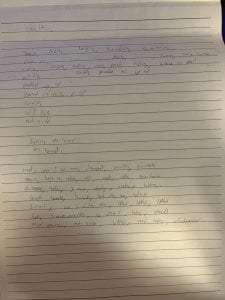
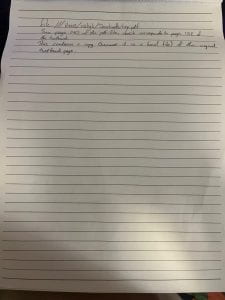

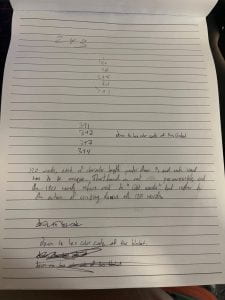
Artist statement:
The original meaning of the artwork was to mock the simple task of writing a schedule, detailing a plan of action, doodling etc by showing the power random people have seemingly over us and changing/influencing what we want even though it’s our journal. I’m exaggerating my critique on how our minds seemingly function, and questioning why we let people dictate our actions. But as the playtest went on, the meaning of the game changed. It became more of critiquing unrealistic tasks that we are given on a daily basis. Everything from school to home life, it’s all a crumpled mess because doing it all seems impossible. We work so hard to reach a goal only for our work to be rendered useless or something comes up that delays us from accomplishing that goal. The new version of “Thoughtless Objectives” is supposed to be representative of this feeling. Being the notetaker, you are under an immense time crunch, trying your hardest to finish the task while the person is actively trying to sabotage you. The person only wins by making the notetaker give up; this was intentional in order to hit home the idea that there is no real reason for making things difficult for a person besides satisfaction in a person’s misery. Although the task given is supposed to be possible, the person can dance on the line between extremely difficult and impossible. As I witnessed in my playtests, I had a person tell the notetaker to count all the candy on the floor (being over 400 candies). While the notetaker did attempt it, they ultimately failed. On a personal level, there are times where I feel like everything is just conveniently against me. With every mistake I make or extra time I take, the dumber I feel amongst my peers. The more I feel this way the more I listen to others rather than myself. Even with this project, I feel like the real intervening was the playtesters’ feedback vs my original idea.
Intervention: The Northeastern ARG
Overview:
My intervention project was a Northeastern ARG, or ‘alternate reality game.’ These typically involve using real-world locations or settings and creating a fictitious narrative for players to follow. A lot of times these games involve puzzle-solving, and thus a mysterious and intriguing element is almost tradition for these types of experiences. I decided to follow suit and create a short puzzle game that would take place on campus, with players tasked to uncover data about a supposed “Northeastern Conspiracy” that is hidden somewhere on campus using clues posted in different locations to track it down.
Rules:
Two locations near to each other on campus were identified, and this is where the ‘clue’ pages were left. I wanted to keep the number of clues needed to solve the puzzle to an absolute minimum so that students passing by would potentially be more interested in playing the ARG as it would be over very quickly. The ‘A’ page contained a key with letters corresponding to numbers and symbols:
| 1 | 2 | 3 | 4 | 5 | 6 | 7 | 8 | 9 | ! | ^ | $ | % | – | * | ( | ) | & | + | [ |
| a | r | s | g | t | h | y | l | r | f | o | m | e | d | i | n | c | u | b | k |
Meanwhile, the ‘B’ page contained the location of the data itself, but encoded using this key:
!2^$ 56% 97-%9 6188 3*4( 5&9( 9*465 1(- 6%1- 1)2^33 56% 359%%5 5^ 56% 5188 42133 12^&(- 56% 3*-% ^! +%621[*3 56% -151 *3 6*–%( *( 56% 42133
In addition to the piece of the clue, the two types of pages would each list the location of the other type of page, meaning that regardless of which page was found first a player would know where they needed to go to make their end of the puzzle work. Put together, the two clues would reveal the following sentence: “From the Ryder Hall sign, turn right and head across the street to the tall grass around the side of Behrakis. The data is hidden in the grass.” Just as the clue states, the ‘data’ (which itself was a piece of paper with text on it) was hidden outside in a weatherproof bag for players to eventually find.
The paper itself contained an absurd description of the process of paying tuition to the school, described in a way that made it sound like criminal activity. However, it was revealed at the end that this was all a joke and part of my ARG to avoid any unintentional distress or people taking my game more seriously than it was meant.
Artists Statement:
Certain in-class examples, such as the Barbie Liberation Organization, created scenarios where a false ‘narrative’ was created by intervening in a real-life space. In that instance, a fiction that the toys themselves were rebelling against their company was created using the setting of real stores in a manner that interacted with real people. While my ARG was more interactive than this- I was still inspired to try and use the ARG to facilitate my own fictional narrative. I wanted to create a tongue-in-cheek parody of the idea that there was a conspiracy going on at Northeastern that poked fun at some of the most common student complaints about the University. In this way, it acted as a very small form of protest while simultaneously being an absurd narrative that somehow there was an organization dedicated to uncovering the secrets that players could interact with throughout the game.
Unfortunately, in my attempts to set it up on campus, I was stopped by student employees at Northeastern both times I tried to put up my posters at my planned locations- unfortunately preventing me from seeing the results of my intervention as I had originally intended. In hindsight, I should have planned to put them in locations that were more free for students to put up posters but I am inherently limited by what I’m allowed to do on campus- and it is possible this project wasn’t feasible given the time I would need to coordinate it with the school. I was also concerned about player participation in my game, and whether or not anyone would take the time to do it. I think had I planned a wider setup of my posters this and the previous problem could have been alleviated.
Photos:
Here are some photos of me attempting to put up the posters and hide the clue:

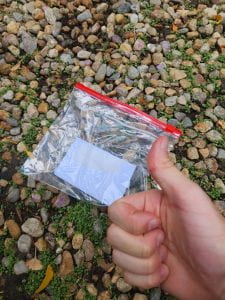
Artwork 2: Appropriate – The King’s Cards
The King’s Cards – by Tim Doyle
The Rules:
- 2-4 Players allowed
- Play a game of Uno, only the objective is to collect as many cards of the same color by the end of the deck
- By the end of the game, whichever colored card you have the most of is your designated color, and you gain 1 point per card you have
- All special cards maintain their properties (skip cards, reverse, wild cards, etc)
- If by the end of the game two or more players have been collecting the same color, they all lose
- If by the end of the game you have cards not belonging to your color, you must subtract points from your score
I originally centered the game around the rules of King’s Cup, where whichever card is drawn dictates some action the players have to complete, but those rules didn’t transfer over very well to the context of this class. I was suggested to try and use Uno cards to make the game more intuitive, by using the numbers and colors to dictate certain actions and make it easier to remember what it is the player should do, but that was still too complicated. After my first play test outside of class, I found that it was still difficult and confusing to use rules dictated by King’s Cup using cards that weren’t from a standard deck. Eventually, I decided to scrap the rules of King’s Cup entirely and chose to appropriate the rules of Uno instead. I wanted my rules to emphasize division and segregation, so I used the different colors as the centerpiece surrounding my appropriation. The original game of Uno already plays with this idea of using a card’s color to dictate the player’s options, where you can only play one color card per turn unless you meet some specific scenario, but I decided to turn up the use of the colors in my appropriation. Instead, you are forced to collect as many of the same color as you can.
The play tests were simple and easy, as the game of Uno is not very difficult to comprehend. What I noticed is that it was difficult to gather a large amount of cards because of the nature of Uno, but that was alright in the end because you technically didn’t need a lot of cards to win the game.
The game isn’t made to be super balanced, but it was crafted to be a more artistic take on the use of the cards themselves. I drew a lot of inspiration from some of the works in Dada, and more specifically the simple creativity that the artists used in their works. My favorite art pieces from the book were very derivative of the original piece, where they heavily used the source material in their appropriated work, focusing more on putting a simple and creative twist on the work instead of completely warping it. This is what my game has in common, where the game fundamentally feels the same as a regular game of Uno, but the simple change in win conditions completely changes how the game is actually played by the players.
Super Mario Bros.: Just-Like-You-Remember-It Edition!
The Game:
Super Mario Bros.: Just-Like-You-Remember-It Edition! features five levels of memory-deteriorating fun!
Built upon “Super Mario Bros” by Github user Gold872
…which is recreating some old video game from the 80s or something.
Artist’s Statement:
If you’ve ever played the game Super Mario Maker, or its inventively titled sequel Super Mario Maker 2, you’ve perhaps encountered the many remakes of Super Mario Bros.’s first level, 1-1. These are plentiful and unavoidable when playing this game online. Some people twist the level, adding traps and fire bars everywhere. Some remakes are perfectly accurate, but most aren’t. Many of these remakes get small details in spacing wrong. Some of them miss entire parts of the level. As time passes, which details of the games we play are we still able to remember?
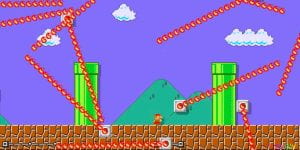
I’m not sure I remember it like this… (pictured: Super Mario Maker 2)
This game project was primarily inspired by the plunderphonic works of Daniel Lopatin (AKA Oneohtrix Point Never, AKA Chuck Person), James Leyland Kirby (AKA The Caretaker), William Basinski, and various artists in the vaporwave genre, as well as the appropriation works of the Dada movement.
Daniel Lopatin in 2010, under the pseudonym Chuck Person, released a limited-run cassette tape of 80s pop songs looped, slowed down, and distorted into what he coined “eccojams”. By taking somber lyrics of songs out of context, Lopatin creates a haunting reinterpretation of these once-hits. These eccojams are heavily concerned with the idea of memory. They feel like distant memories of one part of a song, randomly getting stuck in one’s head years later. Lopatin re-released several of them on his audiovisual project “Memory Vague”. He approaches the idea of memory deteriorating at the end of the tape’s first side, where it gets more and more distorted and noisy until the original sample has been fully drowned out by a pulsing harsh noise.
Another artist even more concerned with the deterioration of memory, specifically in relation to neurodegenerative diseases like Alzheimer’s, is Leyland Kirby, who produces music as The Caretaker. The Caretaker’s most well known albums, “An empty bliss beyond this world” and “Everywhere at the End of Time”, are based on a study where people with Alzheimer’s were able to recall associated memories from the music of their youth. Both albums feature 1920’s music scavenged from record stores, looped and echoed into distant memories. “Everywhere at the End of Time,” Kirby’s final project as The Caretaker, is comprised of six stages reflecting the progression of Alzheimer’s disease. Kirby’s work is often compared to William Basinski’s “Disintegration Loops”, an album of tape loop experiments where the tapes continually deteriorate as they’re played.
The Dada movement saw many artists (although they themselves at the time may have rejected the term, time and Wikipedia have come to know Dada as an art movement) appropriating found objects, twisting their meaning and purpose into new subversive works. While these artists were very interested in specifically using found objects, I am mostly interested in the way these repurposed objects lose or alter their meaning. When Kurt Schwitters repurposes machine parts, old newsprint, or bus tickets, they lose their ability to function as intended. Using these appropriated works in collage puts them in a new context and assigns them new meaning. When Marcel Duchamp creates a readymade statue out of a bicycle wheel or a urinal, he assigns it new meaning as a work of art. I love this idea of assigning new meaning to existing things through selection and transformation.
These projects got me thinking about applying the idea of memory deterioration to games. Artists like Basinski use the decay of physical artifacts to create their art, but digital games don’t degrade in the same way. I wanted to capture the idea of a poorly-remembered level, such as that seen in Mario Maker 1-1 remakes. I wanted to loop one piece of a game into infinity, like Daniel Lopatin or Leyland Kirby did with their music. I wanted the entire thing to collapse in on itself by the end like the Disintegration Loops, because at some point, everyone’s memory runs out.
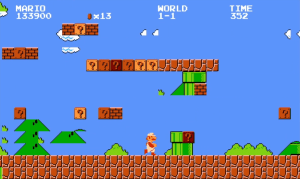
I originally wanted to use a game other than Super Mario Bros., but it was the easiest to find an accurate recreation of to modify for this project. It also worked well to work off of a game with wide familiarity, since the game should ideally be concerned with a level the player actually does remember. I took the structure of 1-1 and created five levels from it.
The first level is exactly 1-1, recreated perfectly, in a fairly accurate recreation of the original game.
The second level is slightly off. The spaces between key moments of the level have been altered, and powerups may be in different locations. The music has been slowed down slightly. This level is meant to represent misremembering the small details of the level design, as many Mario Maker recreations do.
The third level begins repeating key structures of the level, or forgetting some entirely. The music does something similar, repeating portions of the iconic overworld theme and skipping occasionally.
The fourth level repeats the beginning of the level over and over again. I consider this the “eccojam level”, as one moment is repeated again and again. The music is inspired by the second eccojam on the tape, called “angel”. It loops one section of the song, speeding it up and down in a disorienting manner. One moment it resembles the original bouncy track, and the next it briefly slows to a chiptune dirge.
The fifth and final level represents the final deterioration of a memory of this level. The level design and background elements repeat and glitch in nonsensical ways, only vaguely resembling the looping beginning of the level. The music is slow and drawn out, randomly pausing for large amounts of time and twisting into sounds the NES would not be able to replicate. Eventually, the iconic features of the level vanish, and the empty land soon gives way to an uncrossable abyss, as the memory eventually fades away.

At some point, everyone’s memory runs out.

